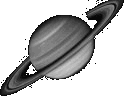
Blackholes Forum Message | |
| Forums: |
Atm ·
Astrophotography ·
Blackholes ·
Blackholes2 ·
CCD ·
Celestron ·
Domes ·
Education
Eyepieces · Meade · Misc. · God and Science · SETI · Software · UFO · XEphem |

 |
|
 |
||||
|
|
||||||
Be the first pioneers to continue the Astronomy Discussions at our new Astronomy meeting place... The Space and Astronomy Agora |
| Re: Tanx To U All....
Forum List | Follow Ups | Post Message | Back to Thread Topics | In Response To Posted by Jim Bergquist on February 24, 2001 05:04:37 UTC |
|
In regards to the article that you refer to, for an object in circular orbit the radius of the orbit remains constant. Hence the radial velocity and acceleration are both zero even though the x-y motion is sinusoidal and therefore exhibits changes in linear velocity and linear acceleration. The relation between the radius and the x-y coordinates is r² = x² + y². For a circular orbit, x = r*cos(theta) and y = r*sin(theta). theta = w*t where w is dependent on the radius of the circular orbit. If r = 6400 km, the Earth's radius, at theta = 0, then x = 6400 km and y = 0 km. A quarter of the way around the Earth, theta = 90 degrees and x = 0 km and y = 6400 km. But for both positions, r = 6400 km; there is no change in the radius.
|
|
| Additional Information |
|---|
| About Astronomy Net | Advertise on Astronomy Net | Contact & Comments | Privacy Policy |
|
Unless otherwise specified, web site content Copyright 1994-2025 John Huggins All Rights Reserved Forum posts are Copyright their authors as specified in the heading above the post. "dbHTML," "AstroGuide," "ASTRONOMY.NET" & "VA.NET" are trademarks of John Huggins |